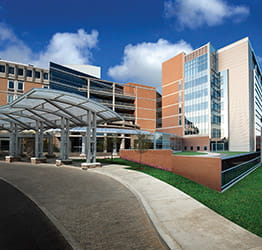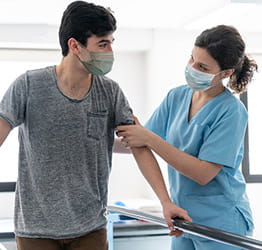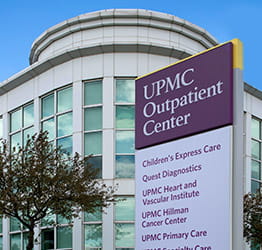On this page
What Is HER2-Negative Breast Cancer?
HER2-negative (HER2-) breast cancer is a type of breast cancer diagnosed when the cancer cells lack HER2 proteins. Consequently, HER2-negative breast cancer does not respond to treatments that target HER2 proteins to slow or stop cancer growth.
What are the types of HER2-negative breast cancer?
Most types of breast cancer are HER2-negative, including:
- HR-positive and HER2-negative breast cancer (HR+/HER2-) — Cancer cells have estrogen and/or progesterone hormone receptors, but no HER2 proteins.
- HR-negative and HER2-negative breast cancer (HR-/HER2-) — Also known as triple-negative breast cancer (TNBC), cancer cells lack estrogen or progesterone hormone receptors or HER2 proteins.
What are the stages of HER2-negative breast cancer?
Like other types of breast cancer, doctors use a standard system to determine the stage of HER2-negative breast cancer. UPMC uses the American Joint Committee on Cancer (AJCC) TNM staging system.
TNM staging is based on seven variables:
- Tumor size (T) — How big is the tumor? Has it spread?
- Nodes (N) — Has the cancer spread to any nearby lymph nodes? If so, how many?
- Metastasis (M) — Has the cancer spread to any distant organs, like the lungs or liver?
- Estrogen receptor (ER) status — Does the cancer have an estrogen receptor protein?
- Progesterone receptor (PR) status — Does the cancer have a progesterone receptor protein?
- HER2 status — Does the cancer make too much HER2 protein?
- Grade of the cancer (G) — Are the cancer cells normal looking?
Each variable is assigned a numerical value based on its severity, and the total determines the cancer stage.
Breast cancer stages are:
- Stage 0 — The cancer is noninvasive.
- Stage I — Cancer cells have appeared in a duct or lobule and have invaded nearby tissue but have not spread beyond the breast.
- Stage II — The tumor is between three-quarters of an inch and 2 inches (2 cm-5 cm) and may have spread to lymph nodes under the arm. Or the tumor is larger than 2 inches (5 cm) but has not spread to the lymph nodes under the arm.
- Stage IIIA — The tumor has spread to lymph nodes behind the breastbone but has not grown into the chest or skin.
- Stage IIIB — The cancer has spread to the chest wall or breast skin and may have spread to the lymph nodes.
- Stage IIIC — The cancer has spread to the chest wall or breast skin or has spread to the lymph nodes above or below the collarbone, axillary (armpit), or breastbone.
- Stage IV (metastatic) — The cancer cells have spread beyond the breast to other organs.
How common is HER2-negative breast cancer?
HER2-negative breast cancer makes up more than 80% of breast cancer cases.
What causes HER2-negative breast cancer?
Researchers aren’t sure what causes HER2-negative breast cancer.
What are HER2-negative breast cancer risk factors and complications?
HER2-negative breast cancer risk factors
You may be at increased risk of developing HER2-negative breast cancer if you have:
- A family history of breast cancer.
- Exposure to high levels of estrogen or progesterone, such as through hormone therapy.
- The BRCA1 or BRCA2 genetic mutation.
Complications of HER2-negative breast cancer
HER2-negative breast cancer doesn’t respond to medications that target HER2 proteins to slow or stop cancer growth.
How can I prevent HER2-negative breast cancer?
There is nothing you can do to prevent HER2-negative breast cancer.
Back to top
What Are the Signs and Symptoms of HER2-Negative Breast Cancer?
Symptoms of HER2-negative breast cancer are similar to other types of breast cancer and may include:
- A change in the size or shape of your breast.
- A dimpled, puckered, or "orange-peel" appearance of your skin.
- A lump or thickening on your breast or under your arm, which could be painless, firm, or fixed.
- A nipple that turns inward (retracts).
- Bloody or fluid discharge from your nipple.
- Breast or nipple pain.
- Red or swollen skin on your breast, nipple, or areola (the dark circle of skin around your nipple).
- Swollen lymph nodes under your arm or near your collarbone.
When should I see a doctor about my HER2-negative breast cancer symptoms?
If you notice symptoms of breast cancer, you should schedule an appointment with your doctor as soon as possible. Early diagnosis and treatment can improve your chances of survival.
Back to top
How Do You Diagnose HER2-Negative Breast Cancer?
To diagnose HER2-negative breast cancer, your doctor will ask about your symptoms, perform a physical exam, and order imaging tests and a biopsy.
What to expect during your visit
If your doctor suspects HER2-negative breast cancer, they will:
- Ask about your symptoms.
- Ask about your family history of breast cancer.
- Perform a physical exam.
- Order a biopsy to learn about the type of cancer you have.
- Order imaging tests.
- Review your health history and medications.
Tests to diagnose HER2-negative breast cancer
Imaging tests
Your doctor may order diagnostic imaging studies of your breast or other areas of your body, including:
- 3D mammogram (tomosynthesis) — A safe, noninvasive x-ray of your breast tissue. Your doctor may use computer-aided detection (CAD) software, which highlights abnormalities in your breast tissue.
- Chest x-ray — A painless, noninvasive test that creates an image of your chest and lungs.
- CT scan — A painless, noninvasive test that uses x-ray technology to capture multiple cross-sectional images of organs, bones, and tissues inside your body.
- Magnetic resonance imaging (MRI) — A safe, noninvasive imaging test that uses a magnetic field and radio waves to produce highly detailed images of breast tissue without radiation exposure.
- PET scan — Positron emission tomography (PET) is an imaging scan that shows abnormal cell activity within your body's tissues.
- Ultrasound (sonography) — A painless, noninvasive test that uses high-frequency sound waves to produce real-time pictures of your breast tissue.
Breast cancer biopsy and pathology testing
If your imaging tests show a suspicious area of breast tissue, your doctor will perform a biopsy. During a biopsy, your doctor will remove a sample of tumor tissue and send it to the lab for testing.
Types of breast biopsies include:
- MRI-guided breast biopsies — Use MRI guidance to precisely locate suspicious areas of breast tissue so they can be removed to check for signs of cancer.
- Stereotactic breast biopsies — Use mammography guidance to precisely locate suspicious areas of breast tissue so they can be removed to check for signs of cancer.
- Ultrasound-guided breast biopsies — Use ultrasound guidance to precisely locate suspicious areas of breast tissue so they can be removed to check for signs of cancer.
A doctor called a pathologist will perform tests to determine whether your cancer has HER2 proteins or hormone receptors. Your test results will give your doctor more information about the type of breast cancer you have, which will be used to guide your treatment.
HER2-negative breast cancer prognosis
Your prognosis after a HER2-negative breast cancer diagnosis will depend on the type and stage you have, as well as your overall health, response to treatment, and other factors. Your doctor will discuss your prognosis with you.
Back to top
How Do You Treat HER2-Negative Breast Cancer?
The goals of HER2-negative breast cancer treatment are to remove or destroy the cancer cells and reduce the risk of recurrence.
Treatment options may include:
Surgery for HER2-negative breast cancer
Surgery may be an option for HER2-negative breast cancer that has not spread beyond the breast or nearby lymph nodes. Your doctor may recommend surgical procedures, including:
Breast cancer surgical procedures
- Lumpectomy — Also known as breast-conserving surgery or partial mastectomy, lumpectomy is a surgical procedure to remove the part of your breast with a cancerous tumor and some healthy surrounding tissue.
- Mastectomy — A surgical procedure to remove the entire breast. When both breasts are removed, it is known as a double mastectomy.
Lymph node surgical procedures
- Axillary lymph node dissection — Surgery to remove all or a group of lymph nodes in the axilla (armpit), if your sentinel lymph node biopsy is positive for cancer.
- Sentinel lymph node biopsy — A minimally invasive procedure to remove the sentinel (main) lymph node in the axilla (armpit) to test it for cancer. It is performed to determine if cancer has spread to your lymph nodes.
Radiation therapy for HER2-negative breast cancer
Radiation oncology is a medical specialty that uses radiation therapy to kill cancer cells. Radiation therapy for breast cancer involves using high-energy x-rays to precisely target your tumor. It may be used after surgery or in combination with other therapies to treat HER2-negative breast cancer.
Medical oncology for HER2-negative breast cancer
Medical oncology for breast cancer involves using different types of anti-cancer medications to slow or stop breast cancer growth.
Your doctor may recommend treatments including:
Chemotherapy for HER2-negative breast cancer
Chemotherapy is a breast cancer treatment that uses medications that travel through your bloodstream to kill cancer cells throughout your body. It can be used alone or in combination with other treatments. Your doctor may recommend chemotherapy:
- After surgery, to kill any remaining cancer cells.
- Before surgery, to shrink the tumor so it can be removed more easily.
- If your cancer has spread to other areas of your body.
Targeted therapy for HER2-negative breast cancer
Your doctor may recommend targeted therapies that work similarly to antibodies produced naturally by your immune system. These antibodies identify and attack foreign cells, including cancer cells.
Immunotherapy for HER2-negative breast cancer
Immunotherapy is a breast cancer treatment that uses medications to boost your immune system’s ability to identify and kill cancer cells. It is often combined with chemotherapy to treat HER2-negative breast cancer.
HER2-negative breast cancer clinical trials
UPMC experts participate in national, multicenter clinical trials that study promising treatments for HER2-negative breast cancer.
This means you can take part in research that has the potential to enhance breast cancer care and access groundbreaking treatments years before they are available to the public. Your doctor will let you know if a clinical trial might be an option for you.
Why choose UPMC for HER2-negative breast cancer care?
When you choose UPMC for HER2-negative breast cancer care, you will receive:
- Comprehensive breast cancer expertise — The breast cancer experts at UPMC provide state-of-the-art care for every form of breast cancer at every stage of the disease.
- Personalized, collaborative care — Our surgical, medical, and radiation oncologists work together to plan the best course of therapy for you.
- Supportive services tailored to your needs — Our approach to breast cancer care honors your preferences by blending advanced clinical methods with supportive services for the best possible results.
Back to top
By UPMC Editorial Staff. Last reviewed on 2025-09-18.
















